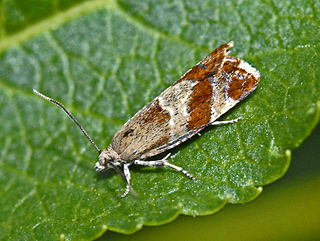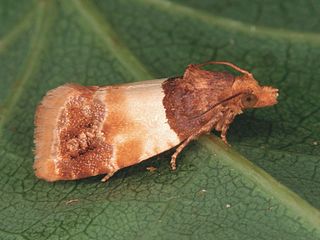
Epinotia immundana is a moth of the family Tortricidae. It is found in China (Qinghai), Russia and Europe.

Epinotia solandriana is a moth of the family Tortricidae. It is found in Europe, China, Korea, Japan, and Russia.

Epinotia is a very large genus of tortrix moths. It belongs to the tribe Eucosmini of subfamily Olethreutinae.

Epinotia cruciana, the willow tortrix, is a moth of the family Tortricidae.
Epinotia rubiginosana is a moth of the family Tortricidae. It is found from Europe to eastern Russia, China, Korea and Japan.

Epinotia brunnichana is a moth of the family Tortricidae. It is found in most western, central and northern Europe, the Near East and further east to the eastern Palearctic realm, where it has been recorded from Russia, Kazakhstan, China, and Japan.

Epinotia festivana is a species of moth of the family Tortricidae. It is found in most of southern Europe and the Near East.

Epinotia thapsiana is a moth of the family Tortricidae. It was described by Philipp Christoph Zeller in 1847. It is found in the Netherlands, France, Spain, Portugal, Switzerland, Austria, Italy, Slovakia, Hungary, Slovenia, Serbia, North Macedonia, Albania, Greece, Russia, Asia Minor, Iran, Kyrgyzstan, Tajikistan, Turkmenistan, China and Korea.
Epinotia absconditana is a species of moth of the family Tortricidae. It is found in Australia, where it has been recorded from New South Wales and Queensland.
Epinotia tenebrica is a species of moth of the family Tortricidae. It is found in Morona-Santiago Province, Ecuador.
Epinotia illepidosa is a species of moth of the family Tortricidae. It is found in Morona-Santiago Province, Ecuador.
Epinotia majorana is a species of moth of the family Tortricidae. It is found in north-eastern China, Korea, Japan and Russia.
Epinotia monticola is a species of moth of the family Tortricidae. It is found in Taiwan.

Epinotia nemorivaga, the bearberry bell, is a species of moth in the family Tortricidae. It is found in Europe and Asia.
Epinotia notoceliana is a species of moth of the family Tortricidae. It is found in China (Hebei) and Russia.
Epinotia pentagonana is a species of moth of the family Tortricidae. It is found in China (Jilin), Korea, Japan and Russia.
Epinotia piceicola is a species of moth of the family Tortricidae. It is found in Taiwan, Japan and Russia.
Epinotia pinicola is a species of moth of the family Tortricidae. It is found in China, Korea, Japan and Russia.
Epinotia salicicolana is a species of moth of the family Tortricidae. It is found in China (Shaanxi), Taiwan, Japan and Russia.

Epinotia vertumnana is a species of moth of the family Tortricidae. It is found in North America, where it has been recorded from southern Ontario and Quebec to eastern Pennsylvania, then to Michigan and from there to northern Mississippi and eastern Texas.








